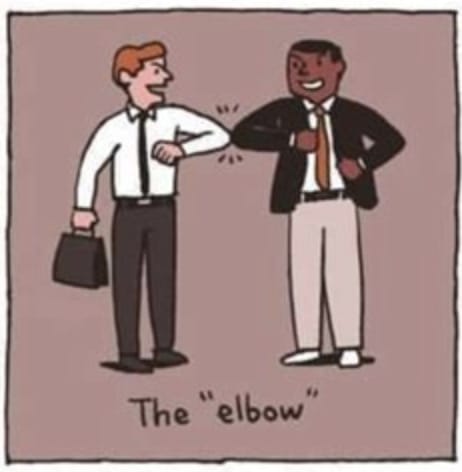Proposal: Butt bumps as a default for physical greetings
As Tim Urban explains in The Great Perils of Social Interaction, greetings are hard.[1]
I’ll be 90 and I still won’t have figured this out. There are different rules for everyone and nothing’s clear—Do I shake my grandfather’s hand or go for the hug? How about my friend’s father? Old friend? New friend? Opposite-sex acquaintance? Longtime work colleague? Sibling’s good friend who I’m meeting for the second time? It’s unbelievably complicated.
And there aren’t just two options you’re choosing from—there’s the high school bro handshake/backslap douche possibility, there’s the vertical, loose-hand high-five that morphs into a weird springy-finger tension thing as you snap away, there’s even the easy but taking-yourself-really-seriously non-ironic fist pound. And even if you both go for the hug, there’s a question of duration and firmness and who’s in charge of those decisions.
Frankly, I’m embarassed that we still haven’t figured this one out. We’re rationalists, after all. We understand coordination. Aren’t we supposed to WIN?
Yes. Yes we are. I refuse to consider us The Kind That Can’t Cooperate. I refuse to lose to barbarians.
That’s why, today, I am taking action. Instead of sitting on my hands, I shall stand up and do something about this problem.
I propse that, as a default, universal greeting, we adopt the butt bump.
Why? We could instead go with something like “the elbow”...
...but, well, that’s just a little boring. Butt bumps feel like a more fun theoretically sound solution due to a variety of properties they possess.
In everyday situations, they are quick and easy to perform.[2]
If, however, you want to add some flair to it, you can include a namaste.
If you are celebrating an achievement, you can jump, aiming to bump butts in the air.
If you are in a good mood and have your party pants on, you can get a little jiggy.
And of course, if there is ever another pandemic, we’ll be well prepared.
I also predict that, being an unusual form of greeting, they would enhance feelings of ingroup connection. Think about people who have secret handshakes.
Imagine yourself showing up to a meetup for the first time. You see one other person standing there and approach them to say hi.
Eye contact is made. The physical distance between you and them is closing.
You slowly start to swivel your hips, hoping desperately that the other person reciprocates.
Imagine the sense of belonging you’ll feel when they do.
As an actionable next step, assurance contracts seem like the right tool for the job. Please reply with your username to this comment if you agree to the following vow if 100 others agree, and this comment if you agree if 1,000 others agree. If you agree to the former it is implied that you agree to the later.
I {username} vow to, for the next three months, when greeting a person for whom I am reasonably confident to be a rationalist, swivel my hips clockwise in an attempt to initiate a butt bump. If they reciprocate, I will proceed to perform the butt bump. If they do not reciprocate within three seconds, I will unswivel my hips and proceed as I desire.





Please reply with your username to this comment if you agree to the following vow if 1,000 others agree.
James Camacho
Metacelsus
I was concerned about the competing standards problem but your comment solves the issue
Is there a default direction to twist for the butt bump? The pictures all show the greeters facing in the same direction so one must have turned left and the other right! How do I know which way I should twist?
I cannot sign the assurance contract until I understand this fundamental question
Great question and point! I just used a proprietary GPT-U that is specialized in user research. It scanned the web and determined that 81% of people are inclined to twist clockwise. I’ll update the vow to clarify.
Penn & Teller: Bullshit! from 2004 (episode Safety Hysteria):
Please reply with your username to this comment if you agree to the following vow if 100 others agree.
Adam Zerner
Keenan Pepper
The part that seems rude to me isn’t the “you made a mistake” part, it’s the way it was communicated. The subtext feels contentious (well that’s not quite the right word) in a way that easily meets the threshold I have for “I’d like to see less of that”.
I feel like this is a sneaky promotion for “page bird”, and I also am unsure if “page bird” exists.
If it’s a Schelling point, why do we need you to tell us?
Because what it actually is is an April fool joke, and to be funny jokes have to be actually made. So I assume, anyway. (It would be hilarious if this actually resulted in a norm among rationalists of greeting one another with butt-bumps, but fortunately that seems unlikely.)
https://manifold.markets/RomanHauksson/will-butt-bumps-be-the-default-phys
Well, gee, I didn’t realise that, and I don’t find it funny that rationalists keep banging on about Schelling points without knowing what they are.
https://www.lesswrong.com/posts/Kbm6QnJv9dgWsPHQP/schelling-fences-on-slippery-slopes?commentId=ZoNHCAzvLgd8hJ9pC
Now that they have told us, it is a Schelling point
Indeed. The way I would describe this is: “X is a Schelling point” can be either
Descriptive speech, like “X is blue”; you are telling me something about the world that is true whether you tell me or not.
Enactive speech, like “I promise to be there”; you are telling me something about the world that is true because you said it.
(Or even a combination, where something was already mostly a Schelling point but now it’s a stronger Schelling point.)
That’s not how they work.
Ah, I see now that I misunderstood Schelling points. I’ll edit the post. Downvote for being rude though.
Note: The title of this post was originally “Butt Bumps as a Schelling point for physical greetings”.
I don’t think this misunderstands schelling points. By creating common knowledge, you can change the schelling point from being one strategy, to being a different strategy. The schelling point at t=0 does not have to be the same as at t=80.
(Or more concretely, Grand Central Station wasn’t a Schelling point in New York before it was built. Before that time, presumably there were different Schelling points.)
I think we can distinguish between humans changing the environment in a way that happens to create a Schelling point, vs communicating to create a coordination strategy.
Wikipedia at least agrees with TAG’s definition.